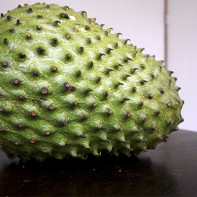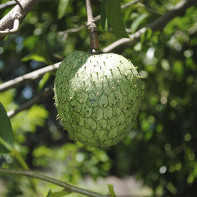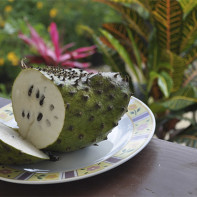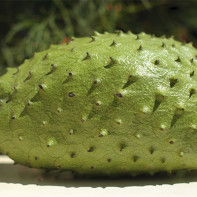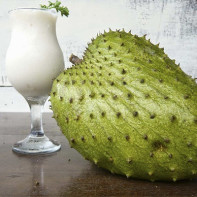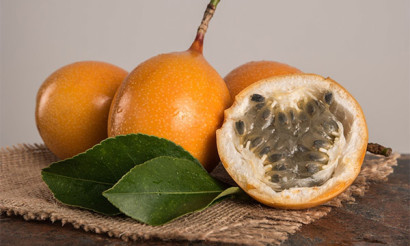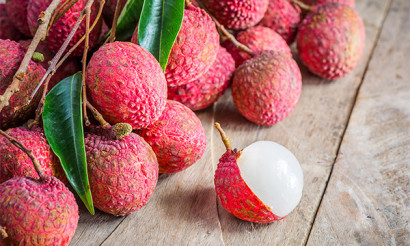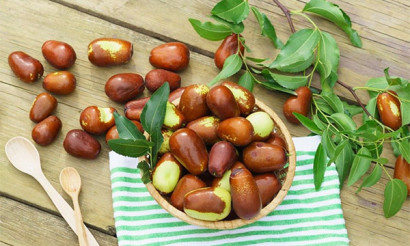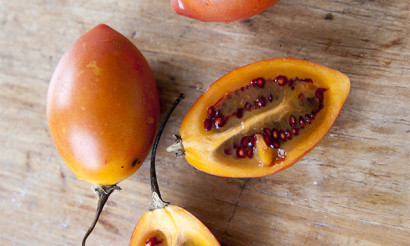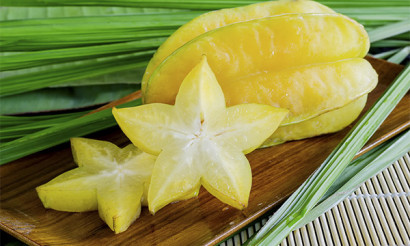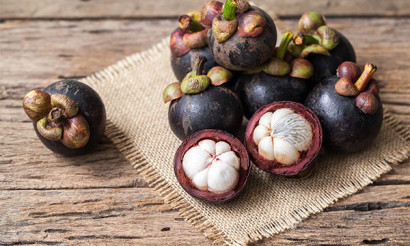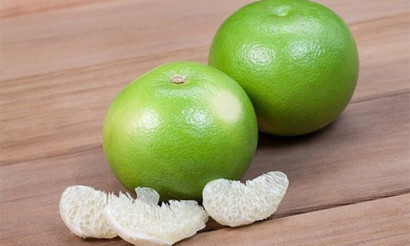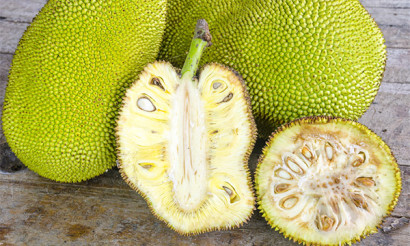Guanabana fruit: useful properties and contraindications
Guanabana is one of the popular exotic plants with juicy and fragrant fruits. It is common in the wild, but has been cultivated in countries with suitable climates for more than a century. Guanabana fruits are of particular culinary value - they have a distinct aroma and flavor. But this is not all the benefits of the plant, because guanabana is a treasure trove of valuable minerals, vitamins and biologically active substances that can regenerate the body and help in various diseases. To use the therapeutic power of the fruit of guanabana, you need to know its useful properties, contraindications and features.
- What is guanabana
- How it looks and where it grows
- Composition and calories
- Therapeutic properties of the guanabana fruit
- Cooking applications
- Pudding with annona
- Marshmallow
- Ice cream from guanabana
- Hazards and contraindications
- How to choose and store
- How to eat guanabana correctly
- Interesting Facts
What is guanabana
Guanabana is a plant that is more commonly known as sausep. The plant is also referred to as the "sour apple." Guanabana is one of the most popular members of the genus Annona. The scientific name of this evergreen tree is Annona prickly. This plant is considered to be the largest of all representatives of the genus.
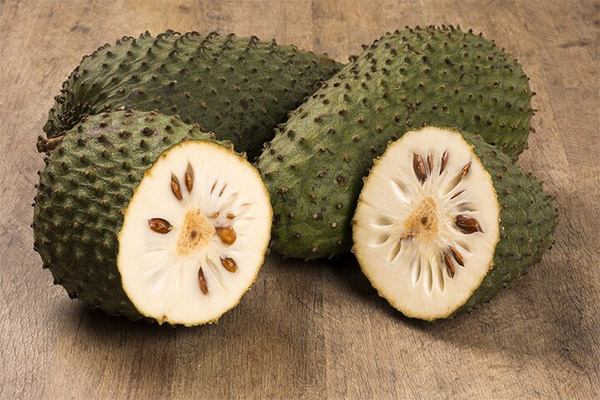
Guanabana is of interest not only to gardeners who are engaged in its cultivation. Pharmacists have been studying it for decades, because its fruits and leaves contain unique components that can affect biochemistry in the body. Today sausep is also of interest to geneticists - this prolific plant is studied by breeders, and more productive, early-ripening hybrids are regularly produced.
The most valuable thing about this plant is the fruit. They are rich in minerals and vitamins, have a sour-sweet taste and a bright fruity-berry aroma. The pulp is used to make desserts, cocktails, wine, soft drinks and alcoholic beverages. A significant disadvantage is that guanabana fruits spoil too quickly because of the high sugar content, so they are never transported in a ripe form. Harvest before the fruits are ripe, so that they do not have time to rot during transportation.
What it looks like and where it grows
Annona prickly is a tropical plant that is found on nearly every continent. It grows in China, Sri Lanka, grown in Australia, India. The tree is quite heat-loving, and it cannot bear fruit in a deficit of sunlight, so you can't grow it under artificial conditions.
Botanical characteristics:
- The height of the tree is about 6-9 m.
- Leaves are large, broad, leathery and dark green outside, light green inside.
- The fruits are multilocular, large, pear-shaped with prickles on the surface.
The fruits of this tree are quite large, they can grow the size of a large melon and weigh more than 6-7 kg. The peculiarity of the plant is that the fruits can ripen both on the branches and on the trunk. Guanabana bears fruit in the 3rd-4th year after planting.
Composition and calories
Guanabana is not the most dietary product. The pulp of this fruit contains many carbohydrates of different types, so you should not abuse it in the afternoon. 100 g of the product contains 94 kcal, but if you subject the pulp to heat treatment, the caloric value of the product decreases from 94 kcal to 56 kcal per 100 g. 100 g of the product contains up to 10 g of carbohydrates (sucrose, fructose, polysaccharides). Fats and vegetable proteins are also present in the pulp - up to 1 g per 100 g.
The plant contains a full range of minerals and a mass of vitamins that are well assimilated by the body. Here is a complete list of active substances that are part of annona:
- Iron - participates in hematopoiesis, prevents the development of anemia.
- Sodium and potassium - maintain water-salt balance, protect the heart, normalize blood pressure.
- Zinc - involved in the regeneration of skin cells, improves hair and nails, strengthens the nervous system.
- Magnesium - relieves nervous tension, activates brain activity, is necessary for insomnia and increased irritability.
- Vitamin PP - responsible for the strength and elasticity of blood vessels, prevents problems of the reproductive system.
- B vitamins - responsible for the immune system, nervous system, health of internal organs, skin condition.
- Antioxidants - protect against cancer, premature aging, infections.
- Vitamin C - activates defense mechanisms, helps to cope with infections, strengthens the walls of blood vessels and thinning the blood.
In addition, the fruit pulp contains organic acids, as well as a small concentration of fats. They help speed up metabolic processes in the body, purify blood vessels and the liver. Regular consumption of guanabana rejuvenates, strengthens the immune system, improves hair and skin, and also significantly increases the productivity of the brain.
Therapeutic properties of the guanabana fruit
Even in ancient times, the natives of warm countries where guanabana was grown knew how useful its fruits were. Therefore, they actively used the sour cream apple for medicinal purposes. But recent studies of the fruit's composition have also provided scientific confirmation that the sausage is indeed a therapeutically valuable product. Scientists have identified at least 10 of the fruit's most beneficial properties for the human body.
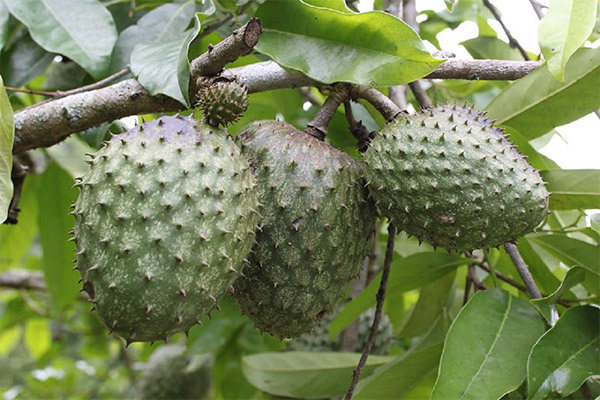
- Guanabana is useful for cancer. It contains plant components that inhibit cancer cells and prevent them from dividing. In addition, the fruit is rich in antioxidants, which neutralize free radicals and stop the growth of tumors.
- The fruit is useful for inflammatory processes of any localization, as it has anti-inflammatory properties. This is also due to the abundance of antioxidants found in the pulp.
- Guanabana fruits contain high amounts of vitamin C, which is a powerful antioxidant. Because of this, it boosts the immune system and helps the body to cope with viruses and bacterial infections.
- Guanabana is effective in preventing heart attacks and strokes. The active components of the fruit break down cholesterol and remove it from the body.
- Guanabana also normalizes blood pressure.
- The full complex of minerals and vitamins of group B restore the nervous system after stresses, contribute to improvement of brain functioning, and also stabilize the emotional state.
- Annona has a pronounced laxative effect, as it contains a large amount of fiber. The fruit normalizes intestinal function, restores microflora, improves digestibility.
- Guanabana prevents premature aging and protects cells and cell structures from damage.
- Due to the presence of special mineral compounds, the fruit pulp has a beneficial effect on heart function and protects the heart muscle from premature wear and tear.
- The pulp of the fruit is incredibly valuable for the health, beauty and youthfulness of the skin. It activates cell regeneration, stimulates the production of collagen necessary for skin elasticity.
The anti-tumor properties of guanabana are especially important. Scientists have found that eating this fruit significantly reduces the risk of tumors, as well as increasing the chances of recovery from existing cancer. Contrary to the popular myth, guanabana cannot replace chemotherapy or radiation, as it is not capable of destroying already developed cancer cells. But the consumption of this product significantly helps the body to fight and recover. Guanabana is not a substitute for basic cancer therapy, so it can only be considered a supplement. But there are a few nuances that those who plan to use guanabana while fighting cancer need to be aware of.
- There are no clinical studies to date genuinely confirm the anti-cancer efficacy of the fruit.
- There are no guanabana-based extracts or supplements that can cure cancer without traditional treatments.
- Scientists have only been able to study some of the properties of this fruit. They came to the conclusion that the consumption of this fruit rich in antioxidants is able to stop the growth of tumors, but this effect is achieved only in 60% of cases.
- It is not recommended to use guanabana as a therapeutic measure, it can only be used as one of the components of the diet.
- It is strictly forbidden to eat annona fruit every day for more than a month. It contains toxic components for the brain and liver, which, if accumulated in the body, can lead to severe intoxication.
- In order to get the maximum antioxidants when eating the fruit, it should not be subjected to heat treatment.
- It is necessary to consult with a doctor and clarify the possibility of introducing the exotic product into the diet.
- It is categorically forbidden to use the product when bleeding has opened or a pronounced deterioration as a result of the progression of the disease.
It is worth noting that not only the fruit of the plant has medicinal properties. Annona prickly leaves are also used for medicinal purposes, contain essential oils, phytoncides and flavonoids. Tea from dried leaves helps with fatigue, insomnia, stress, chronic fatigue. Leaves are also used to prepare infusions for external use - with them you can take a bath, make compresses and rubbing at muscle pain and joint disease.
Culinary Applications
The main use of guanabana is for culinary purposes. In Asian, Javanese, and Australian cuisine, desserts with this fruit are as popular as apple pie in our latitudes. The most common way to eat it is raw. This way the taste of this exotic fruit is fully preserved, and the concentration of valuable components is not lost.
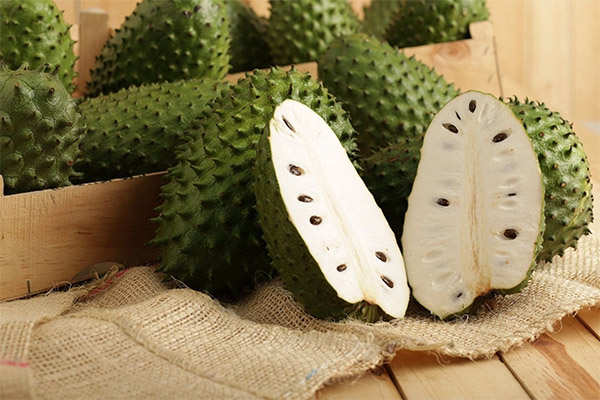
Raw guanabana is eaten not only in its pure form. It is used in many dishes and drinks.
- Guanabana cocktails are made with the addition of fruit, berries, milk.
- From the fresh fruits of the plant make delicious juices with pulp, adding other components, such as pineapple and orange.
- Raw guanabana is used to make ice cream.
- The pulp is used to make a base for mousses.
- The flesh is sliced and used for fruit slices and canapés.
Raw guanabana has a tart, sour-sweet taste and a distinct aroma. This should be taken into account when selecting foods to be combined with this fruit. But you can also make many other quite tasty dishes with annona fruit.
Annona pudding
To prepare a pudding, you can take a ready-made dry mixture, and also combine the fruit with other exotics. You can make pudding on the basis of milk - then it will be distinguished by a delicate taste, and properly chosen proportions of ingredients will allow you to maximize the flavor notes of each of them.
Ingredients:
- 500 ml of milk or 1 package of dry concentrated pudding powder;
- 400 grams of seedless annona fruit pulp;
- ½ cup sugar;
- vanilla;
- 2.5 tablespoons of corn starch.
You need to bring the milk to a boil and pour in the sugar, starch and vanillin. Stir and simmer for 2 minutes. Add the pulp, gradually grated into a pulp and cook for no more than 2 minutes. Pour the pudding into silicone moulds, leave to cool and then place in the fridge for 3 hours. After this time, remove the moulds, then arrange the pudding on plates and garnish. Fresh berries or fruit can be used to decorate the pudding. You can also complement the taste of the pudding with grated chocolate, cocoa-based topping or raspberry syrup.
Marshmallow
Guanabana marshmallows are incredibly light and delicate, and the acidity balances out the flavor. You can make marshmallows as a base for cakes and pastries or use them as a separate treat or dessert.
Ingredients:
- 1 bag of gelatin or agar-agar;
- 400 grams of fruit pulp;
- 3 egg whites;
- 250 grams of powdered sugar.
Pour a little water over the gelatin so that it can dissolve. Whip the egg whites into a foam, gradually adding powdered sugar and mush from the pulp of the fruit. Pour in the dissolved gelatin, but do not take out the mixer, and continue to whip the mixture. The resulting marshmallow mass cool a little, and then put into a pastry bag. Lay a sheet of parchment paper on the spread and use a pastry syringe to make a marshmallow of your preferred shape. Refrigerate until completely solidified and sprinkle with powdered sugar before serving.
Guanabana Ice Cream
Flavorful ice cream with a delicate sweet and sour flavor is a great treat that will be refreshing at any time of year. You can prepare this exotic dish even at home.
Ingredients:
- 200 ml of cream;
- 3 tablespoons of powdered sugar;
- 500 grams of fresh guanabana flesh;
- Thickener (by the tip of a knife).
To make ice cream quickly, you must first have a good cooling of the products. Grind the pulp into a smooth pulp, using a blender. Add cream, powdered sugar and thickener. Whisk well until frothy, and then put in a closed container in the freezer. After 2 hours the ice cream will be ready - you can serve it in waffle cups or in a crème de la crème. It is delicious combined with vanilla or chocolate syrup. You can pour caramel - it complements the sour-sweet taste of annona pulp.
Harms and contraindications
Guanabana is extremely dangerous for those who are allergic to the fruits of this plant. This phenomenon is rare, but if you are prone to allergic reactions, it is better not to risk. In addition, there are other contraindications that make it impossible to use the fruit:
- Diabetes mellitus (the fruit is high in sugar);
- acute pancreatitis;
- diarrhea.
During pregnancy, you can eat this fruit, but only in moderate quantities. During breastfeeding, it is not recommended to introduce guanabana into the diet before 6 months of age. You should consult a doctor before introducing it.
The seeds of the guanabana fruit pose a particular danger to human health. The fact is that they contain toxic substances. Also the pulp of the fruit contains toxins, but in small concentrations. Important to know - daily use for more than 4 weeks can lead to these side effects:
- headaches;
- fainting spells;
- sleep disturbances;
- memory impairment;
- increased irritability;
- impaired movement coordination;
- nausea;
- vomiting;
- impaired speech.
Most often, the toxins contained in annona fruits affect the nervous system, so you should not abuse this product. But also these substances can lead to dysfunction of the liver and kidneys - the natural filters of the body. Such a phenomenon is possible only if the accumulation of toxins in high concentrations with daily consumption.
How to choose and store
To buy the ripe guanabana fruit in regions where it is not grown due to the unsuitable climate is almost impossible. Since the ripe fruits begin to rot in just three days during transportation, they are brought to the stores in their unripe form. But this is not a problem, because literally in a few days the skin of the fruit will turn yellow, after which you can fully enjoy its taste. In addition, there are five rules that will help you choose the most delicious and healthy fruit.

- It is necessary to pay attention to the smell. Do not be frightened by the aroma - ripening annona fruits smell like turpentine. If there is any extraneous aroma, it means that the fruit has been treated with toxic chemicals.
- It is important to pay attention to the size and weight of the fruit. The bigger the fruit, the juicier the flesh, and also the sweeter and more delicious it will be.
- The skin of a well-preserved fruit should be intact and singular, with no cracks, spots, or blotches.
- The ripe annona fruit has a slightly yellowish, yellow-green color. Juicy green fruits are immature, you will have to wait 2-3 days to start eating them.
- Choose only those fruits that have the same shape and size of thorns and a reticulated pattern on the surface of the green skin.
Annona fruits can be stored at room temperature or on the bottom shelf in the refrigerator. If you need to wait for the fruit to ripen, it is better to leave it on a window sill. If you leave the guanabana in the refrigerator, it will take a long time to ripen. The cut or peeled fruit should be consumed within a few hours because the flesh will start to spoil 2-3 times faster if exposed to oxygen. If the flesh of the fruit has turned dark or gives off an unpleasant smell, do not eat it because it is an indication that the fermentation process has already begun.
How to Eat Guanabana Fruit
Annona fruits can be eaten fresh or prepared from them various desserts. The easiest way is to:
- Cut the fruit into slices;
- remove the seeds completely from the pulp;
- eat it with a spoon.
You can choose the pulp from the fruit, mix it with other fruits and make a flavorful cocktail that will saturate the body with a full range of minerals and vitamins.
Interesting Facts
Guanabana has long been considered an ornamental plant, and few people had any interest in it. The thing is that in ancient times people did not know the cause of poisoning by this fruit, and only after some time it was revealed the presence of toxins in the seeds of annona. But these are not all interesting facts from the history of the plant.
- More recently, annona began to be grown in modern greenhouses, where it is possible to create conditions as close to natural as possible.
- Annona can be used as an indoor plant. If full care is provided, you can even get fruits three years after planting.
- Annona contains an acid complex, which is used by manufacturers of expensive Israeli cosmetics for whitening creams and masks, capable of eliminating hyperpigmentation in a few applications.
As you can see, guanabana is a rarely useful product, which also has an appetizing appearance, strong aroma and pronounced taste. Knowing its medicinal properties and the basic rules of use, you can use the full potential of the fruit to promote health, restore the functioning of the body and fight various diseases.
«Important: All the information on the site is provided solely for introductory purposes. Before using any recommendations, you should consult with a health care professional. specialist. Neither the editors nor the authors are liable for any possible harm caused by materials."

